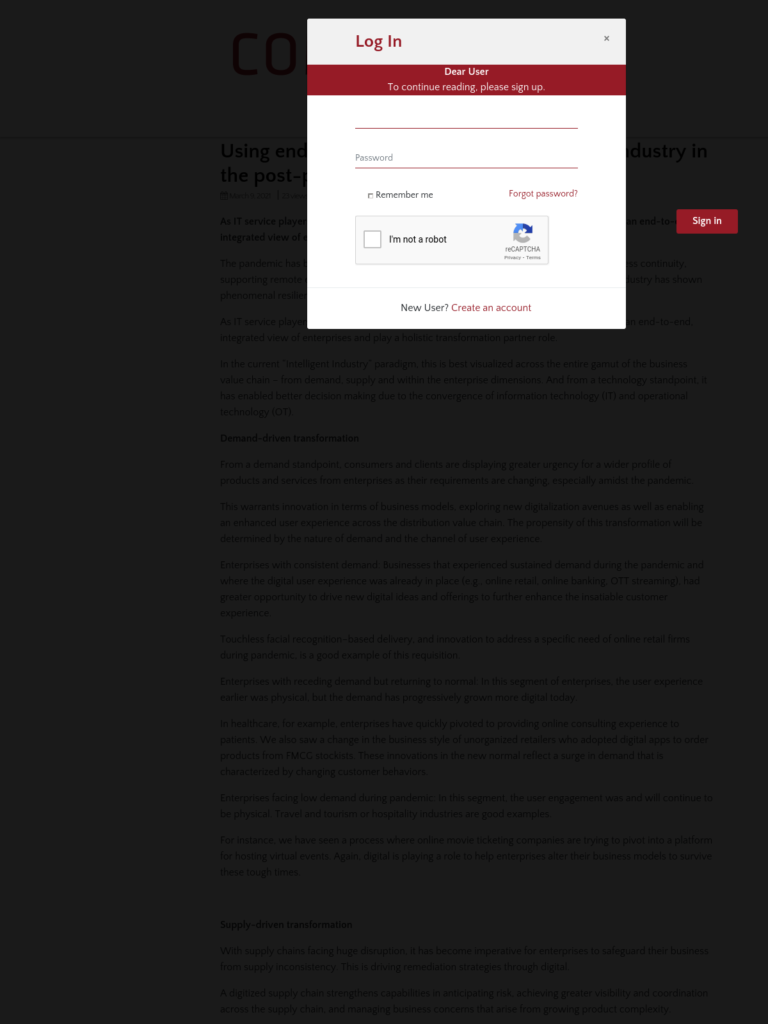Using end-to-end integration to drive the IT industry in the post-pandemic world
Blog: NASSCOM Official Blog
As IT service players pursue opportunities riding on new investments, they need to develop an end-to-end, integrated view of enterprises and play a holistic transformation partner role.
The pandemic has been a litmus test for IT service providers in terms of enabling their business continuity, supporting remote employees and ensuring quality service delivery to clients. Indeed, the industry has shown phenomenal resilience in driving these three priorities well.
As IT service players pursue opportunities riding on new investments, they need to develop an end-to-end, integrated view of enterprises and play a holistic transformation partner role.
In the current “Intelligent Industry” paradigm, this is best visualized across the entire gamut of the business value chain – from demand, supply and within the enterprise dimensions. And from a technology standpoint, it has enabled better decision making due to the convergence of information technology (IT) and operational technology (OT).
Demand-driven transformation
From a demand standpoint, consumers and clients are displaying greater urgency for a wider profile of products and services from enterprises as their requirements are changing, especially amidst the pandemic.
This warrants innovation in terms of business models, exploring new digitalization avenues as well as enabling an enhanced user experience across the distribution value chain. The propensity of this transformation will be determined by the nature of demand and the channel of user experience.
Enterprises with consistent demand: Businesses that experienced sustained demand during the pandemic and where the digital user experience was already in place (e.g., online retail, online banking, OTT streaming), had greater opportunity to drive new digital ideas and offerings to further enhance the insatiable customer experience.
Touchless facial recognition–based delivery, and innovation to address a specific need of online retail firms during pandemic, is a good example of this requisition.
Enterprises with receding demand but returning to normal: In this segment of enterprises, the user experience earlier was physical, but the demand has progressively grown more digital today.
In healthcare, for example, enterprises have quickly pivoted to providing online consulting experience to patients. We also saw a change in the business style of unorganized retailers who adopted digital apps to order products from FMCG stockists. These innovations in the new normal reflect a surge in demand that is characterized by changing customer behaviors.
Enterprises facing low demand during pandemic: In this segment, the user engagement was and will continue to be physical. Travel and tourism or hospitality industries are good examples.
For instance, we have seen a process where online movie ticketing companies are trying to pivot into a platform for hosting virtual events. Again, digital is playing a role to help enterprises alter their business models to survive these tough times.
Supply-driven transformation
With supply chains facing huge disruption, it has become imperative for enterprises to safeguard their business from supply inconsistency. This is driving remediation strategies through digital.
A digitized supply chain strengthens capabilities in anticipating risk, achieving greater visibility and coordination across the supply chain, and managing business concerns that arise from growing product complexity.
For example, the adoption of a new business platform – to identify supplier operations risks in real-time to counter the possible threat of a second COVID-19 wave affecting suppliers in certain regions – by a large automotive OEM in Germany has helped the company redistribute its procurement volumes across other suppliers.
Within-the-enterprise transformation
The pandemic has accelerated the urge and needs for transforming from within, driving companies to do a rethink on employees’ health, safety and productivity.
As remote delivery of services becomes acceptable to clients, IT firms are driving new digitalized ways of working – ushering in Connected Workplaces 2.0. Also, digital is driving transformation with a focus on workers’ health and safety on the shop floor, thereby aligning design and execution team efforts (e.g., R&D and manufacturing) and salesforce productivity to respond to the new situation.
Use of digital technologies for quality control through advanced analytics, robotics and automation to reduce manual errors and improve quality can deliver 30-40% increase in productivity.
For example, a large Indian pharmaceutical firm embraced digital technology in the supply chain in the form of automated material flow, digital information process, and use of augmented and virtual reality for people training and maintenance.
In conclusion, one could say the pandemic has truly cemented the role of technology at the heart of the transformation that enterprises are driving.
Also, enterprises expect greater skin-in-the-game from IT service providers – starting from the business blueprint to architecting to implementing to maintaining continuous improvement of solutions. This is creating exciting opportunities for the IT services sector. These are tough times, but the industry will see it through!
This article is authored by Ananth Chandramouli, Managing Director — India Business Unit, Capgemini
The post Using end-to-end integration to drive the IT industry in the post-pandemic world appeared first on NASSCOM Community |The Official Community of Indian IT Industry.
Leave a Comment
You must be logged in to post a comment.








